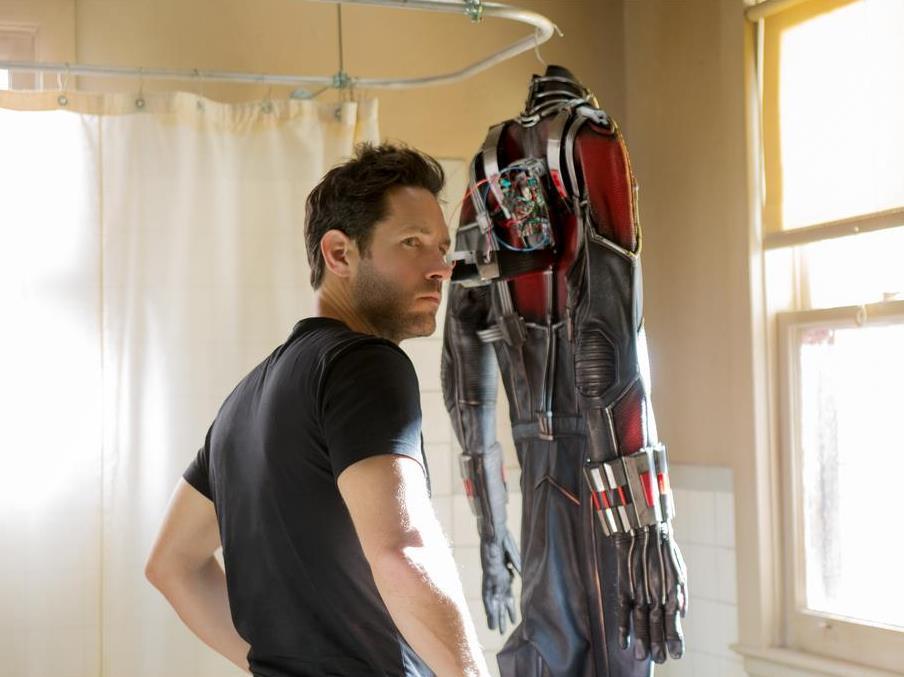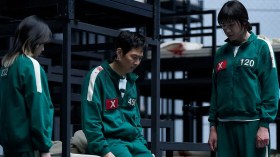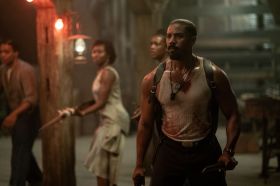In noting that Ant-Man is a smaller entry in Marvel’s cinematic universe, no pun is intended. Nor is the observation only a reflection of the film’s penchant for the petite, as most plainly displayed in the scale that comes with a size-shifting superhero who can command insects. Similarly, the statement doesn’t just reference the content’s less-well known status in the broader public consciousness, with neither the famed comic book company nor others bringing the titular character to the screen prior to now. Though the movie entertains with its many scenes made minuscule, and arrives with less pre-made fan-fare than accompanies The Avengers and its key figures in their separate outings, Ant-Man is small in a compact, contained and even somewhat intimate manner.
Indeed, the narrative and the packaging stress one thing: when it comes to efforts about heroics, bigger isn’t always better. That’s what well-meaning cat burglar Scott Lang (Paul Rudd, They Came Together) learns upon his release from prison, finding himself estranged from his family and unable to secure an honest job. He decides to pursue a significant payday by getting up to his old tricks, but his latest scheme is soon swapped for a quest that shrinks him down to an ant’s level. Inventor Hank Pym (Michael Douglas, And So It Goes) is the man behind the miniaturisation, enlisting Lang’s help to stop Pym’s power-hungry one-time protégé (Corey Stoll, This Is Where I Leave You) from weaponising his organic reduction technology and selling it to unseemly fellows.
In Ant-Man, the core mission pits two men plus Pym’s daughter, Hope van Dyne (Evangeline Lilly, The Hobbit: The Battle of the Five Armies), against another – and yes, that’s a departure from the Marvel Cinematic Universe’s usual city-toppling, world-saving drama. While the larger stakes are never in doubt should Lang, Pym and van Dyne not succeed, this isn’t a film that fills its running time with mass destruction. Instead, the personal cost to two father-daughter relationships sits at the foreground of the feature, threatening to eclipse both the more bombastic displays of action and the broader storyline. After eight previous Marvel movies all going grand in their scale, such a change isn’t just refreshing; even if it is as obvious in garnering an emotional response as the usual planet-in-peril scenario, it’s welcome.
Grounding a superhero origin plot within a heist caper also helps distinguish Ant-Man from its repetitive peers, highlighting its greater fondness for jokes and its personality. Though the troubled history of the production is well-known, with initial director Edgar Wright (The World’s End) leaving the project after an eight-year incubation period, new helmer Peyton Reed (Yes Man) stepping in mere months before shooting started, and two passes at the script made – the first by Wright and Joe Cornish (Attack the Block), the second by star Rudd and Adam McKay (Anchorman 2: The Legend Continues) – the end result finds a fine balance between the usual template elements such as training montages and tie-ins to other Marvel lines, and a lighter tone, modest laughs and brighter, breezier execution.
Here, the micro set pieces prove crucial, condensed in look and but not in feel. Delight and dexterity are equally evident in reducing the perspective to a smaller size and containing the visuals in more mundane places such as bathtubs and briefcases, as Reed zips and zooms through his little realm with verve and vibrancy. Thankfully, he yet never lets the enthusiasm for toying with all things tiny – as well as overseeing ants – overwhelm the tale at the feature’s centre. In fact, Ant-Man is a movie made better by its willingness to slow and shrink down in style and storytelling, rather than blustering forward to service the usual special effects showcase.
The different pace and approach also makes the film a mostly jovial affair with a merry, sometimes mischievous lead to match in Rudd. A winning fit with the material, he smiles and shrugs his way to showing off his usual engaging everyman presence with aplomb, and soars over the rest of the by-the-book cast (a scene-stealing turn from Fury‘s Michael Peña excluded). Though glimpses of how the script and the star may have fared had Wright stayed in charge rank among the movie’s highlights, what evolves from the film’s problematic genesis is still the best things a Marvel feature can be. Focused and modest in its scope and spectacle, rather than sprawling, Ant-Man‘s addition to the fold offers a distinctive, playful and fun superhero effort, as well as one furnished with a great sense of humour.
Rating: 3.5 stars out of 5
Ant-Man
Director: Peyton Reed
USA, 2015, 117 mins
Release date: 16 July
Distributor: Disney
Rated: PG
Actors:
Director:
Format:
Country:
Release:





